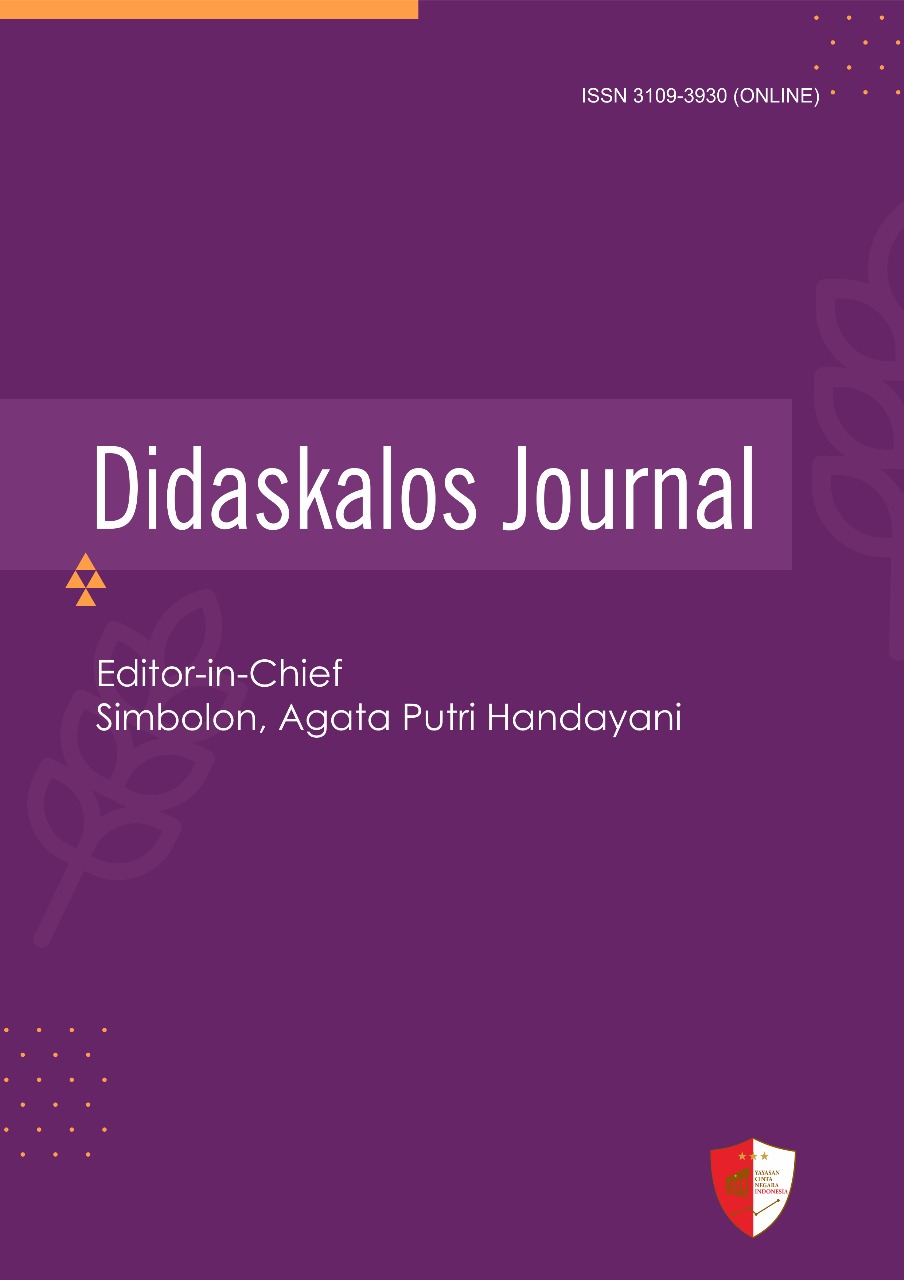The Effectiveness of Implementing the Constructivist Learning Model in Improving Elementary School Students' Conceptual Understanding
Keywords:
Assessment, Collaborative Learning, Conceptual Understanding, Constructivist Learning, Critical ThinkingAbstract
This study investigates the effectiveness of implementing the constructivist learning model in enhancing elementary school students' conceptual understanding. The constructivist approach emphasizes active student engagement, prior knowledge activation, and collaborative learning, which are essential for meaningful knowledge construction. A quasi-experimental design was employed involving two groups of elementary school students: an experimental group receiving instruction through the constructivist model and a control group following traditional teaching methods. Pre-test and post-test assessments were administered to measure students’ conceptual understanding. The findings revealed a significant improvement in the experimental group compared to the control group, indicating that the constructivist learning model effectively facilitates deeper comprehension of academic concepts. The study concludes that adopting constructivist strategies in elementary education can foster improved learning outcomes by promoting active participation, critical thinking, and knowledge retention
References
Anderson, L. W., & Krathwohl, D. R. (2001). A Taxonomy for Learning, Teaching, and Assessing: A Revision of Bloom's Taxonomy of Educational Objectives. New York: Longman.
Arends, R. I. (2012). Learning to Teach (9th ed.). New York: McGraw-Hill.
Ausubel, D. P. (1968). Educational Psychology: A Cognitive View. New York: Holt, Rinehart and Winston.
Biggs, J., & Tang, C. (2011). Teaching for Quality Learning at University (4th ed.). Maidenhead: Open University Press.
Brooks, J. G., & Brooks, M. G. (1999). In Search of Understanding: The Case for Constructivist Classrooms. Alexandria, VA: ASCD.
Bybee, R. W. (1997). Achieving Scientific Literacy: From Purposes to Practices. Portsmouth, NH: Heinemann.
Cobb, P. (1994). Where is the Mind? Constructivist and Sociocultural Perspectives on Mathematical Development. Educational Researcher, 23(7), 13-20.
Creswell, J. W. (2014). Research Design: Qualitative, Quantitative, and Mixed Methods Approaches (4th ed.). Thousand Oaks, CA: Sage Publications.
Darling-Hammond, L. (2000). Teacher Quality and Student Achievement: A Review of State Policy Evidence. Education Policy Analysis Archives, 8(1), 1-44.
Dewey, J. (1938). Experience and Education. New York: Macmillan.
Driver, R., Asoko, H., Leach, J., Mortimer, E., & Scott, P. (1994). Constructing Scientific Knowledge in the Classroom. Educational Researcher, 23(7), 5-12.
Fosnot, C. T. (2005). Constructivism: Theory, Perspectives, and Practice (2nd ed.). New York: Teachers College Press.
Gagne, R. M. (1985). The Conditions of Learning (4th ed.). New York: Holt, Rinehart and Winston.
Gravemeijer, K. (1994). Developing Realistic Mathematics Education. Utrecht: CD-ß Press.
Hake, R. R. (1998). Interactive-Engagement versus Traditional Methods: A Six-Thousand-Student Survey of Mechanics Test Data for Introductory Physics Courses. American Journal of Physics, 66(1), 64-74.
Hmelo-Silver, C. E. (2004). Problem-Based Learning: What and How Do Students Learn? Educational Psychology Review, 16(3), 235-266.
Jonassen, D. H. (1999). Designing Constructivist Learning Environments. In C. M. Reigeluth (Ed.), Instructional-Design Theories and Models: A New Paradigm of Instructional Theory (pp. 215-239). Mahwah, NJ: Lawrence Erlbaum Associates.
Johnson, D. W., & Johnson, R. T. (1994). Learning Together and Alone: Cooperative, Competitive, and Individualistic Learning (4th ed.). Boston: Allyn and Bacon.
Joyce, B., Weil, M., & Calhoun, E. (2011). Models of Teaching (8th ed.). Boston: Pearson.
Kuhn, D. (2007). Is Direct Instruction an Answer to the Right Question? Educational Psychologist, 42(2), 109-113.
Mayer, R. E. (2004). Should There Be a Three-Strikes Rule Against Pure Discovery Learning? The Case for Guided Methods of Instruction. American Psychologist, 59(1), 14-19.
Novak, J. D., & Gowin, D. B. (1984). Learning How to Learn. Cambridge: Cambridge University Press.
Piaget, J. (1972). The Psychology of the Child. New York: Basic Books.
Posner, G. J., Strike, K. A., Hewson, P. W., & Gertzog, W. A. (1982). Accommodation of a Scientific Conception: Toward a Theory of Conceptual Change. Science Education, 66(2), 211-227.
Prince, M. (2004). Does Active Learning Work? A Review of the Research. Journal of Engineering Education, 93(3), 223-231.
Santrock, J. W. (2011). Educational Psychology (5th ed.). New York: McGraw-Hill.
Schroeder, C. M., Scott, T. P., Tolson, H., Huang, T. Y., & Lee, Y. H. (2007). A Meta-Analysis of National Research: Effects of Teaching Strategies on Student Achievement in Science in the United States. Journal of Research in Science Teaching, 44(10), 1436-1460.
Slavin, R. E. (1995). Cooperative Learning: Theory, Research, and Practice (2nd ed.). Boston: Allyn and Bacon.
Strike, K. A., & Posner, G. J. (1992). A Revisionist Theory of Conceptual Change. In R. A. Duschl & R. J. Hamilton (Eds.), Philosophy of Science, Cognitive Psychology, and Educational Theory and Practice (pp. 147-176). Albany: SUNY Press.
Suyono, & Hariyanto. (2011). Belajar dan Pembelajaran: Teori dan Praktik Pembelajaran Abad 21. Bandung: Remaja Rosdakarya.
Taber, K. S. (2006). Beyond Constructivism: The Progressive Research Programme into Learning Science. Studies in Science Education, 42(1), 125-184.
Vygotsky, L. S. (1978). Mind in Society: The Development of Higher Psychological Processes. Cambridge, MA: Harvard University Press.
Wadsworth, B. J. (2004). Piaget’s Theory of Cognitive and Affective Development (5th ed.). Boston: Pearson.
Wood, D., Bruner, J. S., & Ross, G. (1976). The Role of Tutoring in Problem Solving. Journal of Child Psychology and Psychiatry, 17(2), 89-100.
Woolfolk, A. (2013). Educational Psychology (12th ed.). Boston: Pearson.
Downloads
Published
Issue
Section
License
Copyright (c) 2025 Oktaviani Rahayu, Setyawati Yuliana (Author)

This work is licensed under a Creative Commons Attribution-NonCommercial 4.0 International License.




